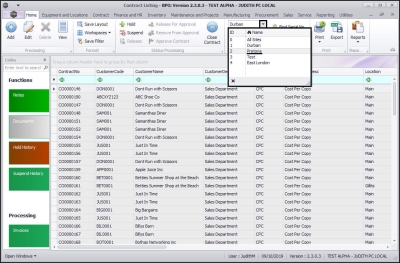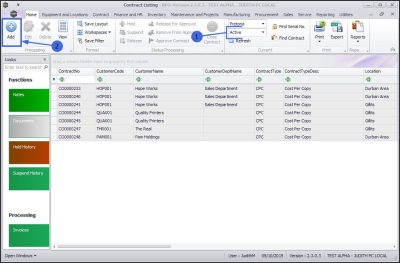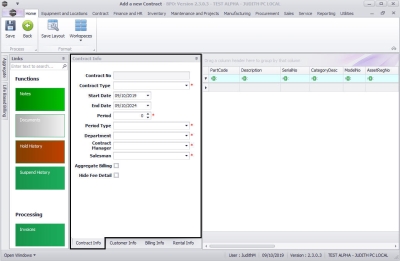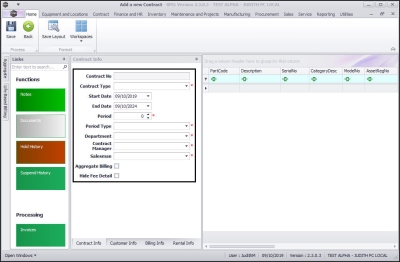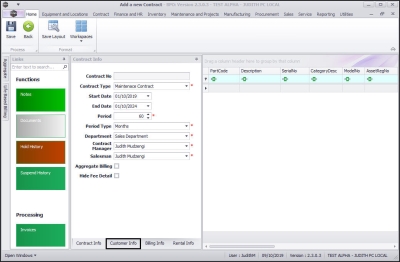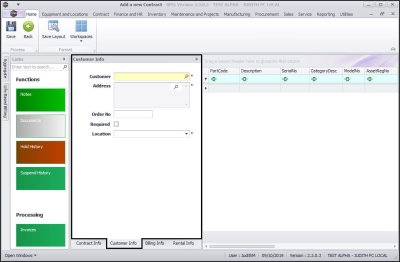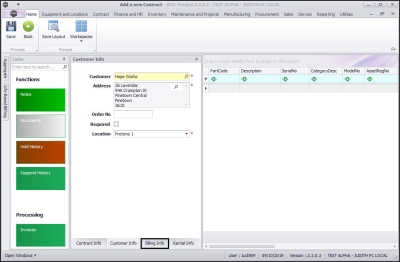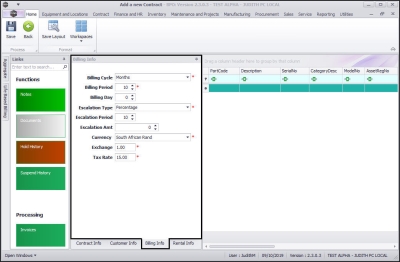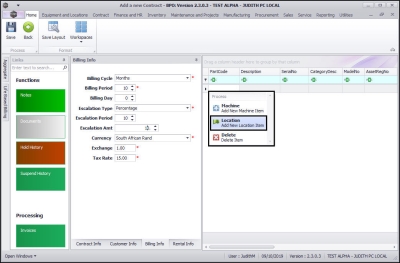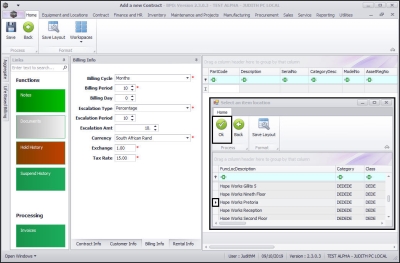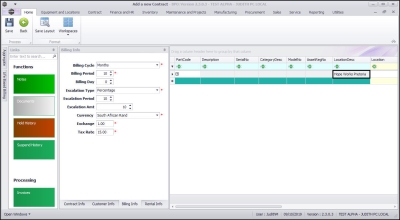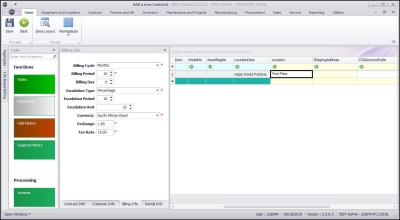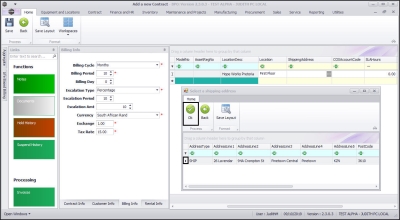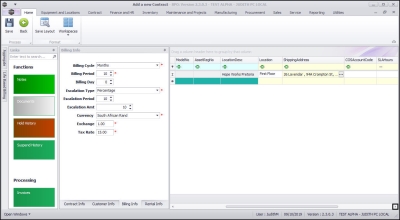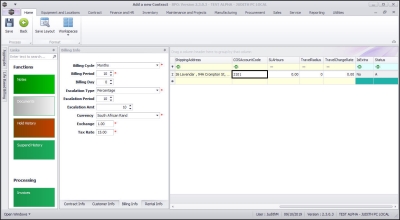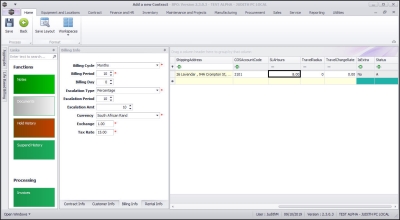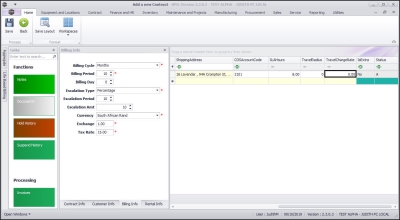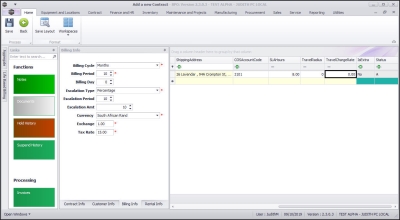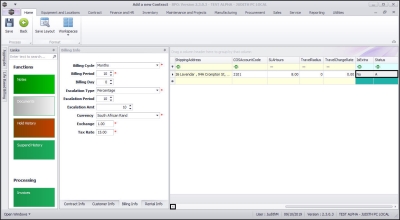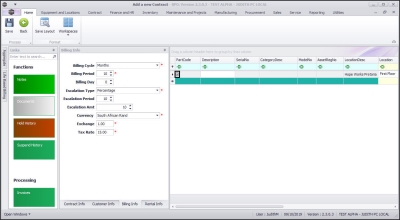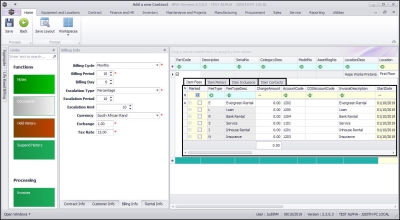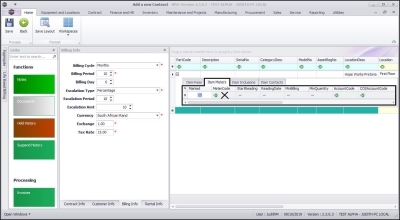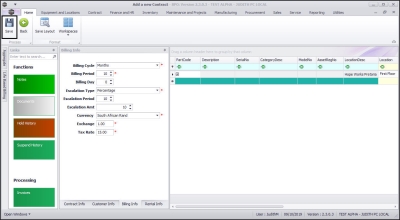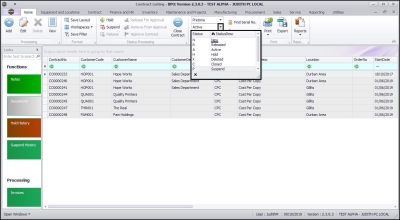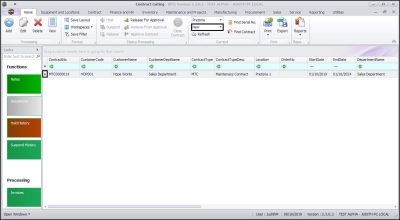We are currently updating our site; thank you for your patience.
Contracts
Add New Location Contract (post v2.3.0.0)
A Customer Location is required for a Customer Location Contract.
The location item that is being added to the contract is a defined customer location.
| Ribbon Access: Contract > Contracts |
The Contract Listing screen will be displayed.
- Select the site that you wish to work in.
- In this image Pretoria has been selected.
- By default, this screen will list all the Active contracts for the selected site.
- You do not need to change this status to create a new location contract.
- Click on Add.
- The Add a new Contract screen will be displayed.
Contract Info Panel
Upon opening this screen, the Info panels are docked, with the Contract Info panel at the fore.
- If not, click on the Contract Info tab.
- The Contract Info panel will move to the fore.
Contract Info Panel Details
- Contract No: The contract number is generated by the system (if the Auto Contract flag is selected in BPO Configurator).
- Contract Type: Click on the drop-down arrow and select the Contract Type e.g., Cost per Copy.
- Start Date: This will auto populate with the current date but you can click on the drop-down arrow and use the calendar function to select an alternative date.
- End Date: This will auto populate 5 years from the start date but you can click on the drop-down arrow and use the calendar function to select an alternative end date if required.
- Note: If this is an Evergreen contract, set your end date to 31/12/2999.
- Period: This will auto populate when the Contract Type is selected but you can either type in or use the arrow indicators to select an alternative period of the contract (life span of the contract).
- Period Type: This will auto populate when the Contract Type is selected but you can click on the drop-down arrow and select an alternative period type (measure relating to the lifespan), e.g., months.
- Department: Click on the drop-down arrow and select the department.
- Contract Manager: Click on the drop-down arrow and select the contract manager.
- Salesman: Click on the drop-down arrow and select the salesman.
- Aggregate Billing: Click on this check box if the customer will receive aggregate billing. Refer to aggregate billing for more information.
- Hide Fee Detail: Select this option if you don't want to show individual contract invoice fee amounts.
Customer Info Panel
- When you have finished editing the contract info details, click on the Customer Info tab.
The Customer Info panel will move to the fore.
Customer Info Panel Details
- Customer: Click on the search button and select the customer from the Select a customer for this contract pop up screen.
- Address: This will autopopulate but you can click on the search button and select the address from the Select an address for this contract pop up screen.
- Order No: Type in the customer order number if required.
- Required: Only select this check box if the client must supply an order number before a technician is sent on site.
- Location: Click on the drop-down arrow and select the customer location from the menu.
Billing Info Panel
- When you have finished editing the customer info details, click on the Billing Info tab.
The Billing Info panel will be expanded.
- Note: Some of these details will auto populate but they can be changed as explained below.
Billing Info panel Details
- Billing Cycle: Click on the drop-down arrow and select the billing cycle (billing frequency, e.g., monthly).
- Billing Period: This is the period when the contract will be billed for the first time. Type in or use the arrow indicators to select the period number.
- Note: The Billing Period relates to the financial period of the company eg if the company's financial year ends on 31 December and a contract is to be billed in February, the Billing Period would be 2.
- Billing Day: Type in the day that the customer will be billed (e.g., on the 25th of each billing cycle).
- The Billing Day can be used if you are billing different contracts on different days or can be used as a filter in the Contract Billing screen. The Billing Day is limited to 31. You can type in the day that the customer will be billed (e.g., on the 25th of each billing cycle) else leave as 0.
- Escalation Type: Search for and Select an escalation type (usually percentage is used).
- Escalation Amount: Type in the escalation amount, depending on the escalation type selected (e.g., 10 if the escalation should be 10%).
- Escalation Period: Type in the financial month at which the system should escalate the contract.
- Note: The Escalation Period relates to the financial period of the company eg if the company's financial year ends on 31 December and a contract is to be escalated in March, the Escalation Period would be 3. If the escalation is on the anniversary of the contract, then use the same financial period as the billing period.
- Currency: The system will auto populate with the currency already set up on the customer but you can click on the drop-down arrow and select an alternative currency if required.
- Note: For foreign currency contracts, all fee and meters charges must be set up in the currency selected e.g., type in the dollar amount if the currency is USD.
- Exchange: The system will auto populate with the exchange rate set up but you can type in an alternative exchange rate.
- Tax Rate: The system will auto populate with the tax rate set up but you can type an alternative tax rate.
Rental Info Panel
- This used for a third party rental contract.
- For more information please refer to Rental Contract.
Aggregate Panel
- This is used when creating an Aggregate contract or Prepaid / Life Based contract.
- For more information, refer to Aggregate contract and Prepaid / Life Based contract.
Life Based Billing Panel
- This is used when creating a Prepaid / Life Based contract.
- For more information, refer to Prepaid / Life Based contract.
Add New Location Item
- Right click anywhere in the row of the Parts frame.
- A Process menu will pop up.
- Click on Location - Add New Location Item.
- The Select an item location pop up screen will appear.
- Select the row of the item location description that you wish to add.
- Click on Ok.
- The selected item location description will now populate the Location Description text box.
- Click in the Location text box.
- Type in a location for this item.
- Click in the Shipping Address text box.
- An ellipsis button will be revealed.
- Click on this button to display the Select a shipping address pop up screen.
- Select the row of the shipping address that you wish to link to this location item.
- Click on Ok.
- Scroll right to view the remaining columns in the Items frame.
- Click in the COS Account Code text box.
- Type in the Cost of Sales account code to be used for WIP (Work In Progress) transaction postings (non-billable toner and spare parts issued as contract included items).
- Click in the SLA Hours text box.
- Type in or use the arrow indicators to select the required call response time (in hours).
- Note 1: If this is set up, SLA will apply every time a call is logged against the contract / contract location. SLA will be calculated based on the shift pattern (customer's trading hours) e.g if the trading hours are from 8am - 5pm and a call is logged at 4pm, SLA will start calculating at 4pm and stop at 5pm and resume the following day at 8am.
- Note 2 : For SLA to work, the shift must be set up in BPO Configurator and linked to the customer.
- Click in the Travel Radius text box.
- Type in or use the arrow indicators to select the distance in km's to and from the client, if this travel is to be billed every time a call is logged. If travel is included, then set this to 0.
- Note: Travel can always be billed separately, if required.
- Click in the Travel Charge Rate text box.
- Type in or use the arrow indicators to select the travel charge rate (e.g., rands per kilometre).
- Note: If you input a non zero value, each time a call is logged against the contract location and the technician travels outside the specified Travel Radius , the Travel Charge Rate will be applied. You will not be able to close the call until the travel charges incurred are invoiced.
- The Is Extra and Status fields are static.
- Scroll left, so that you can view the Part Code column again.
- Click on the Expand button in the Part Code text box.
The selected location Item frame will be expanded.
In this frame are 4 different tabs:
Item Fees
- These are periodic charges e.g., a monthly service fee.
Item Meters
- These are meter usage charges.
Item Inclusions
- These are items included in the contract, not to bill.
Item Contacts
-
This is the contact person - per location item.
- Follow the processes as set out in the Create A New Contract manual to add and or delete;
- Note: In the Item Frame, you will not be able to add Item Meters as this is a Location Contract not a Machine Contract and you cannot link meters to a location.
- You can continue to add contract location items as required, however additional items can also be added later.
- You can also delete contract location items if required.
Save Location Contract
- When you are finished, click on Save.
- The new contract will be saved and you will return to the Contract Listing screen where the status will default to Active.
- Click on the drop-down arrow in the Status field and select the New status.
- The new contract can be found within the New contract status listing screen.
- From here the contract will need to be Released and Approved before it becomes active.
MNU.112.050

